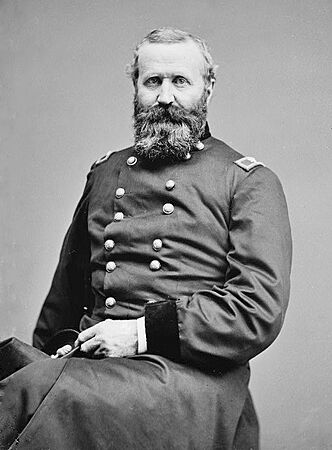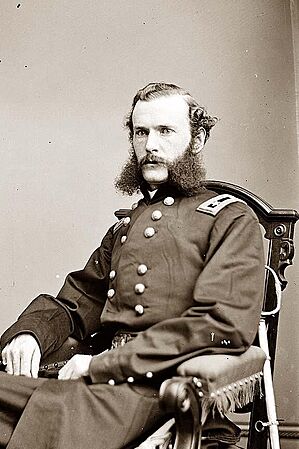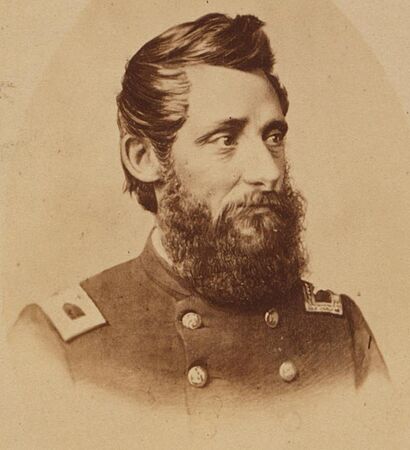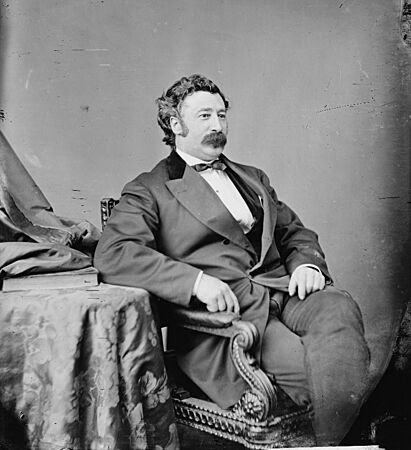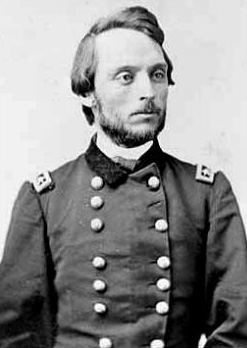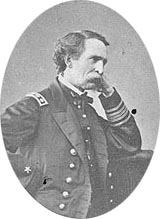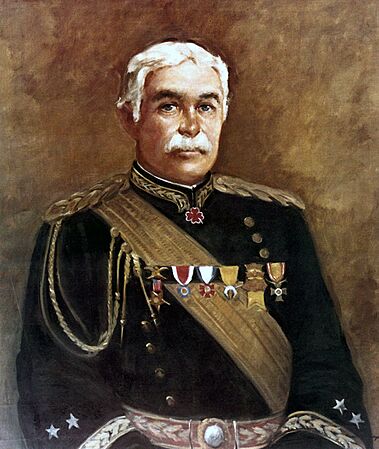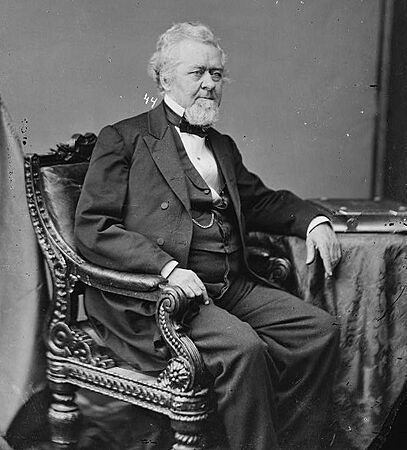Pittsburgh in the American Civil War facts for kids
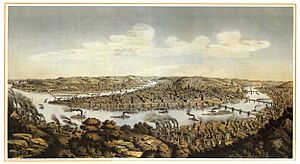
Pittsburgh, Pennsylvania, was a very important city during the American Civil War. It helped the Union Army a lot. Pittsburgh provided many soldiers, war supplies, weapons, bullets, and other important items. The city is located where the Monongahela, Allegheny, and Ohio rivers meet. This made it a key spot for moving goods by river, train, and road.
Contents
How Pittsburgh Helped the War Effort
Making War Supplies and Weapons
Before the war, Pittsburgh's iron industry was strong. It had easy access to coal, iron ore, and good ways to transport iron to markets. In 1859, new methods were used to make iron with coke. When the Civil War started, the need for military goods grew fast. This boosted Pittsburgh's economy. The city made more iron and weapons, especially at the Allegheny Arsenal and the Fort Pitt Foundry.
Pittsburgh made many kinds of weapons. This included ironclad warships and the world's first very large 21-inch artillery gun. By the end of the war, Pittsburgh produced over half of all the steel and more than one-third of all the glass in the United States.
Giant Guns from Fort Pitt Foundry
During the war, Pittsburgh's big factories made many weapons and ammunition. The Fort Pitt Foundry made huge iron parts for giant siege howitzers and mortars. These were some of the biggest guns in the world. One of the largest was a 20-inch Rodman Gun. This was a big, smooth-bore gun that fired black powder.
The foundry made 1,193 guns. This was 15 percent of all the artillery made in the U.S. during the war. It also made almost 200,000 artillery shells. Other important factories in the Pittsburgh area were Singer, Nimick and Co., which made 3-inch cannons. Smith, Park and Co. made over 300,000 shells. Together, Pittsburgh's factories made 10 percent of all the artillery shells used in the war.
Allegheny Arsenal: Making Bullets and Gear
The Allegheny Arsenal was a main factory for the United States Army. It made military gear, saddles, and other equipment for cavalry. This large factory also produced as many as 40,000 bullets and cartridges every day. That's over 14 million per year! It supplied 5 to 10 percent of the Army's yearly needs for small arms ammunition.
Sadly, a big explosion happened at the arsenal on September 17, 1862. This was the same day as the Battle of Antietam in Maryland. The explosion killed 78 factory workers, most of whom were young women.
Building Warships in Pittsburgh
Pittsburgh also helped build ships for the Union Navy. Five Ellet-class ram ships were changed from regular towboats in Pittsburgh. Also, four ironclad ships were built from scratch. These were the USS Manayunk, Marietta, Sandusky, and Umpqua. Pittsburgh's rolling mills made the metal armor for many ironclads. These ships were built in New York City and Philadelphia for the Union Navy.
Pittsburgh's First Stock Exchange
The city's long history of having a major stock exchange started during the war. This happened when Thurston's Oil Exchange was created on Fourth Avenue in downtown. It was set up to trade oil.
Protecting Pittsburgh from Attack
Building Forts to Defend the City
The U.S. War Department worried that the Confederate Army might try to attack Pittsburgh. So, they created the Department of the Monongahela. This group provided a formal Federal military presence in Western Pennsylvania during the Gettysburg Campaign. Its main office was in Pittsburgh.
Maj. Gen. William T. H. Brooks was sent to organize Pittsburgh's defenses. He ordered the building of several miles of earthworks and small forts to control how people could enter the city. He also stopped liquor sales and had citizens dig trenches and build forts. Bars and saloons were asked to close, but many did not.
Key Forts Around Pittsburgh
One of these forts was Fort Robert Smalls. This fort was built by free Black people on McGuire's Hill near Becks Run in Arlington Heights. Another emergency fort was the round earthwork called Fort Laughlin. Employees of Jones and Laughlin Steel built it on Ormsby's Hill. Today, this area is part of Arlington Park. It was also known as Fort McKinley or Fort Ormsby.
At the same time, Jones and Laughlin Steel employees built Fort Jones. It was named after Benjamin Franklin Jones, one of the mill's owners. Fort Jones was on top of a hill in Mount Oliver. Sometimes it was called Fort Jackson, after Brig. Gen. Conrad Feger Jackson, who died in the Battle of Fredericksburg in December 1862. There was also Fort Black in Greenfield.
Important Leaders from Pittsburgh
Many important Union army and navy officers, as well as leading politicians, were born in or lived in the greater Pittsburgh area.
-
Bvt. Maj. Gen. Alexander Hays
-
Maj. Gen. Francis J. Herron
-
Brig. Gen. Benjamin Grierson
-
Brig. Gen. James S. Negley
-
Brig. Gen. John M. Corse
-
Bvt. Brig. Gen. Samuel Young
Other important people from the Pittsburgh area during the Civil War included Col. Daniel Leasure, Congressman Robert McKnight, industrialist William Metcalf, and Brig. Gen. Thomas A. Rowley.
Alexander Kelly, a free Black man who fought in the 6th U.S.C.T., received the Medal of Honor for his bravery.
The mayors of Pittsburgh during the Civil War were George Wilson (1860–1862), Benair C. Sawyer (1862–1864), and James Lowry, Jr. (1864–1866).
Civil War Places to Visit in Pittsburgh
Soldiers and Sailors Memorial
The Soldiers and Sailors National Military Museum and Memorial is a famous landmark. It is the largest memorial in the United States built only to honor all military veterans and service members.
Mount Washington Earthworks
In 2014, a small park was suggested on Mount Washington. You can still see parts of the old earthwork defenses there, overlooking Saw Mill Run.
National Aviary and Former Prison Site
The National Aviary is built on the site of the Civil War Western State Penitentiary. This prison was built in 1826 and torn down in 1882. It was known as a place where prisoners of war were held. The outside looked like a Norman castle, with walls three feet thick. It was shaped like an octagon, similar to a wagon wheel. Prisoners worked in solitary confinement, meaning they were alone. Female inmates sewed clothes and uniforms, and male inmates made shoes. They did all this in silence with very little human contact. The prison had 190 solitary cells, each measuring eight by twelve feet.


